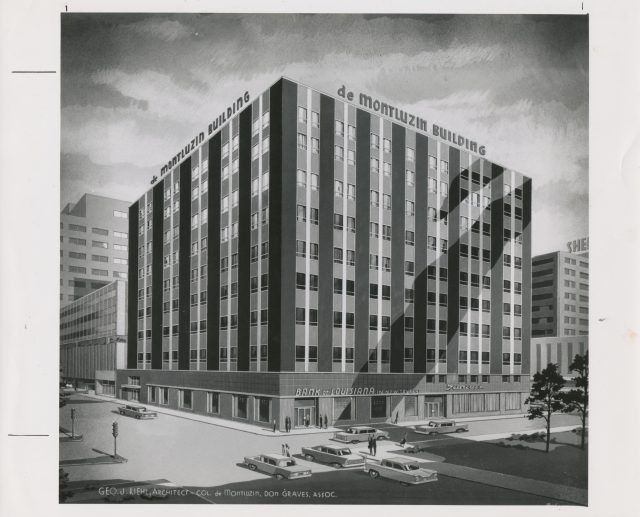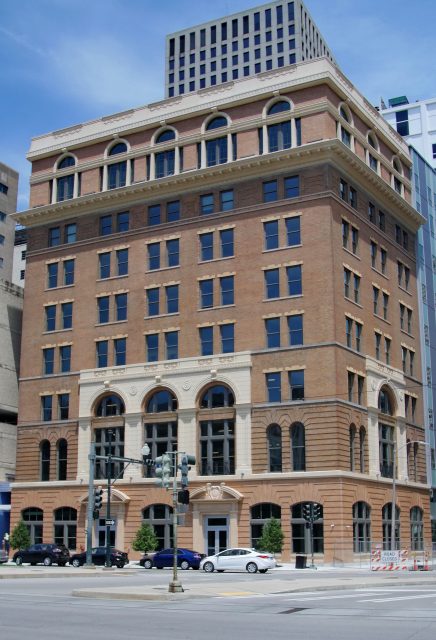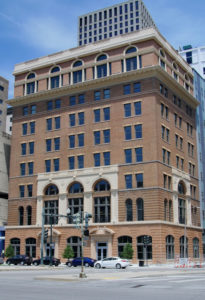Tricentennial Excerpts
Excerpt: Pythian Temple
The Pythian Temple, located at the corner of Loyola Avenue and Gravier Street, has a 100+ year long history
Published: January 23, 2018
Last Updated: December 6, 2018
Note: The following is excerpted from New Orleans & The World: 1718-2018 Tricentennial Anthology, published by the Louisiana Endowment for the Humanities. Click here to purchase a copy.
The Pythian Temple, located at the corner of Loyola Avenue and Gravier Street, was completed in 1909. The seven-story building was constructed by The Grand Lodge, Colored Order of the Knights of Pythias of Louisiana, a club that was founded in 1880 and dedicated to “friendship, charity and benevolence.” Built at a cost of two hundred thousand dollars, the Pythian was purported to be the “biggest business enterprise ever attempted by the colored race in the United States.” Among the African American-owned businesses occupying the offices and retail space was the Unity Industrial Life Insurance Company, led by C. C. Dejoie. Along with a former public school teacher named O. C. W. Taylor, Dejoie founded The Louisiana Weekly newspaper, which had its first office in the Pythian Temple.The Pythian Garden, an open-air venue on the roof of the building, made a lasting impression during the early days of jazz. Trumpeter Manuel Perez led the Pythian Orchestra. Louis Armstrong said of Perez, “Emanuel couldn’t speak so much English, but his horn would speak any language.” A cigar maker like his father, Perez is said to have taken over as the city’s most prominent trumpet player after the death of Buddy Bolden, influencing Armstrong, King Oliver, and Freddie Keppard. The club closed in 1927 and was later reopened by A. J. Piron, whose New Orleans Orchestra played a smoother style of jazz that allowed him entrée to the stages of the Southern Yacht Club and the New Orleans Country Club. Piron is thought to have founded the first African-American music publishing company.
“The Eighth Wonder of the world is not located in the Orient, in the Occident, nor at the North Pole, but right in the city of New Orleans, in the prosperous State of Louisiana. It is not a temple that is dedicated to the gods, but it is a mammoth, modern, up-to-date building, dedicated to the living and built by Negro brains and Negro capital. The name of this pretentious and magnificent structure is the Pythian Temple of New Orleans.”
Green P. Hamilton, Beacon Lights of the Race (Memphis, F.H. Clarke & Brother), 1911
The Pythian’s owners fell on hard times during the Great Depression, and a lawsuit left the building in receivership in 1933. In 1936, the state used the Pythian as temporary quarters for black patients of the old Charity Hospital while the new “Big Charity” was being completed on Tulane Avenue.

Courtesy of General Interest Collection-Office Buildings, New Orleans Public Library.
In 1944, Colonel R. E. E. deMontluzin, the developer of the Gentilly Terrace neighborhood and owner of vast holdings in the then undeveloped eastern marshes of New Orleans, purchased the Pythian for eighty thousand dollars. The Pythian was renamed the Industries Building and became the employment offices for Higgins Industries, the company that famously supplied the federal government with the boats that landed at Normandy on D-Day. There were two entrances for job seekers at the Industries Building: whites entered through the Saratoga Street (now Loyola Avenue) entrance; blacks were directed around the corner to a Gravier Street entrance.
The neighborhood surrounding the Pythian was redeveloped in the 1950s. Known as the Civic Center, the area became home to a new city hall, main library, post office, and rail terminal. DeMontluzin renamed his building the Civic Center building and had the façade covered with porcelain and aluminum to match the new city hall. In later years, the building fell into disrepair. By the time Hurricane Katrina struck in 2005, the former Pythian Temple was unoccupied.

Photo by Romy Mariano, 2017.
In 2017, Green Coast Enterprises and its project partner Crescent City Community Land Trust completed the renovation of the Pythian Temple. Tenants began moving into the Pythian’s sixty-nine apartments in March 2017. The building is part of the revitalization of the Central Business District, which now includes the Loyola Avenue streetcar, a booming restaurant scene, and several other redeveloped historic properties.
